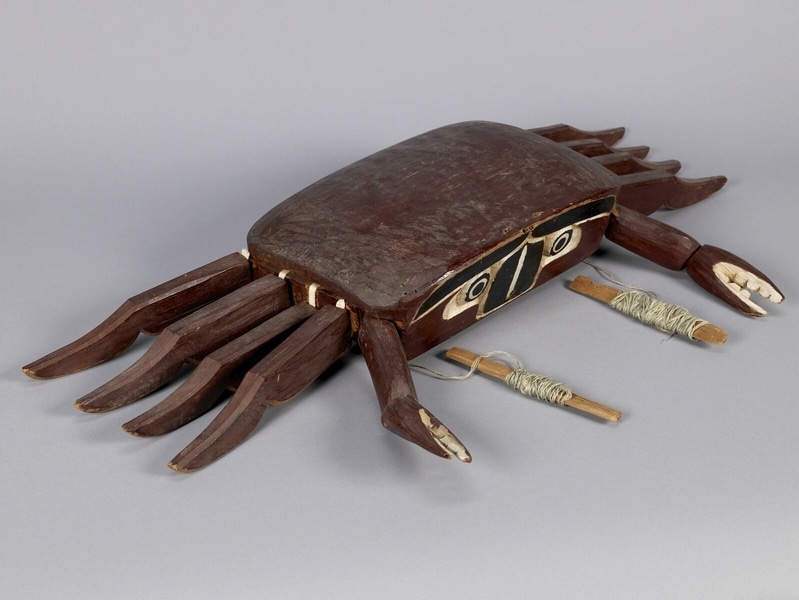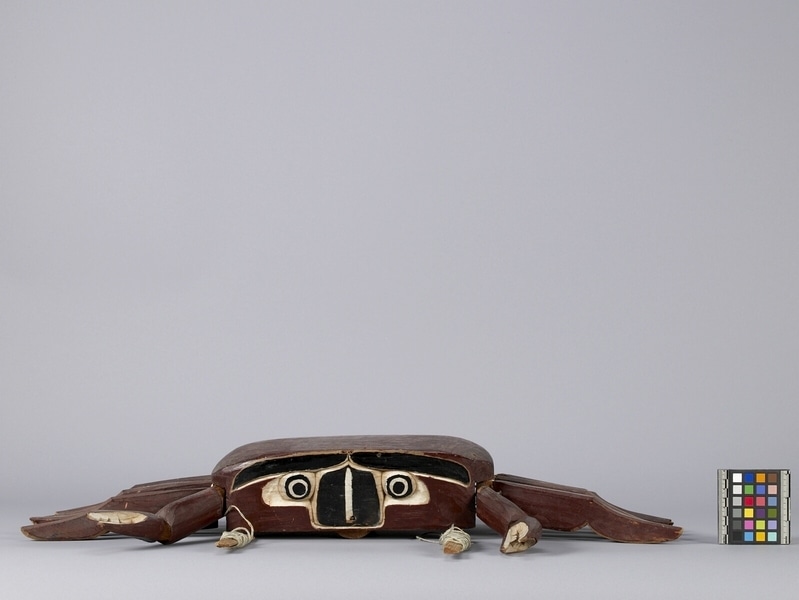Crab Puppet Item Number: A4104 from the MOA: University of British Columbia



Description
Supernatural ground crab puppet. Wooden carved figure depicting a crustacean with four bent legs on each side of the body and two claws on either side of the face. Inside the hollowed-out interior is a spool, which attaches to two spools of string: when pulled, these would allow a person to cause the figure to scuttle along. The figure is painted in brown with black and white details.
History Of Use
These articulated characters are known as dług̱we’ treasures (gamisida długwe'), as are the theatrical dances in which they appear. The Kwakwaka’wakw have a history of puppetry related to their ceremonial feasts. The winter potlatches are known for their spectacular performances, suffused with cultural teachings and supernatural content, such as the coming of Winalagalis, the supernatural warrior. Dances and songs associated with Winalagalis include the tuxw’id, which is performed by women, who have the power and rights to make the dług̱we’ treasures (puppets) come to life. For instance, a tuxw’id dancer could summon a crustacean to life, on invisible cords, in the flickering firelight.
Iconographic Meaning
Represents supernatural Ground Crab of the Woods; a treasure: dług̱we’ of a tux'wid dancer (M. Martin, 1952; C. George, 1966).
Narrative
This piece was witnessed in a ceremony in Kingcome Inlet c. 1919, according to Dick Hawkins (1966).
Item History
- Made by Tom Patch Wamiss (Maker) in British Columbia, Canada before 1920
- Collected in Kingcome Inlet, British Columbia, Canada and Ukwanalis, British Columbia, Canada
- Owned by Emily Watson before October 1952
- Received from H. R. MacMillan (Funding source) and Emily Watson (Seller) during October 1952
What
Who
- Culture
- Kwakwaka'wakw
- Creator
- Tom Patch Wamiss (Maker)
- Previous Owner
- Emily Watson
- Received from
- H. R. MacMillan (Funding source) and Emily Watson (Seller)
Where
- Holding Institution
- MOA: University of British Columbia
- Made in
- British Columbia, Canada
- Collected in
- Kingcome Inlet, British Columbia, Canada and Ukwanalis, British Columbia, Canada
When
- Creation Date
- before 1920
- Ownership Date
- before October 1952
- Acquisition Date
- during October 1952
Other
- Condition
- fair
- Current Location
- Case 24
- Accession Number
- 1874/0013